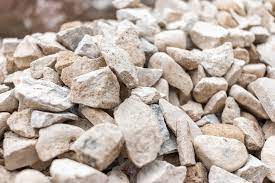
Limestone, an intriguing sedimentary rock, has been an essential component of Earth's geological history and has shaped our planet's landscapes for millions of years. Renowned for its unique properties and diverse applications, limestone holds a significant place in numerous industries and even in the realm of art and architecture.
Limestone, primarily composed of calcium carbonate (CaCO3), originates from the accumulation of marine organisms' remains and inorganic sedimentation processes. The most prevalent source of limestone formation is the accumulation of the skeletal fragments of marine organisms such as corals, mollusks, and microorganisms, over millions of years. The accumulation and subsequent compaction of these organic remains, combined with precipitation of calcium carbonate from water, result in the formation of limestone.
The composition of limestone is not limited to calcium carbonate alone; it often includes impurities and trace elements, which can provide variations in color and texture. Some common impurities found in limestone include silica, clay, iron oxide, and organic matter, each contributing to the rock's distinctive characteristics.
Limestone plays a crucial role in Earth's geological processes and has significant implications for understanding the planet's history. It serves as a key indicator of past environments, offering valuable insights into ancient ecosystems and climate change. Fossilized remains within limestone provide evidence of ancient marine life and serve as a window into the past.
Moreover, limestone is an essential component of the carbon cycle. It acts as a reservoir for carbon dioxide (CO2) and facilitates the removal of this greenhouse gas from the atmosphere. Over time, through various geologic processes such as weathering and erosion, limestone can release carbon dioxide back into the atmosphere, contributing to the natural balance of carbon exchange.
Limestone exhibits a wide range of types and classifications based on its formation and appearance. Some prominent types include:
Biogenic Limestone: Formed from the accumulation of organic remains of marine organisms.
Oolitic Limestone: Composed of small spherical grains called ooids, typically formed in warm, shallow marine environments.
Chalk: A soft, white limestone formed from microscopic marine organisms.
Travertine: Deposited by mineral-rich springs and often used as a decorative stone.
Fossiliferous Limestone: Contains an abundance of visible fossils, showcasing a snapshot of ancient life.
Nigeria, known for its rich mineral resources, is home to abundant limestone deposits. Limestone, a sedimentary rock composed mainly of calcium carbonate, holds immense economic significance and finds numerous applications in various industries. In this article, we will delve into the locations of limestone deposits in Nigeria and explore the wide-ranging uses of this versatile rock.
Locations of Limestone Deposits
Limestone is widespread in the sedimentary basins of Nigeria and it is widely distributed across different states, making the country one of the top limestone producers in Africa. Limestone deposits in different parts of Nigeria are in excess of two billion (2,000,000,000) metric tons.
The major limestone deposits can be found in the following regions:
Cross River State - Cross River State in the southeastern part of Nigeria is renowned for its vast limestone resources. The Mfamosing limestone formation, located in the Calabar Flank, is one of the largest limestone deposits in the country. This deposit has been extensively quarried for both domestic and industrial purposes. Some location where limestone can be found in Cross River state are Mfamosing, Odukpani, Uwet, Akpa, Okranibang, Ugep etc
Ogun State - Ogun State, situated in southwestern Nigeria, is another significant region with notable limestone deposits. The Ewekoro limestone deposit, located in this state, is one of the largest and most commercially exploited in the country. It serves as a major source of limestone for cement production.
Some location where limestone can be found in Ogun state are Ewekoro and Sagamu.
Benue State - Benue State, located in the middle belt region of Nigeria, is home to substantial limestone deposits. The Dangote Cement Plant in Gboko, Benue State, heavily relies on the Gboko limestone deposit for its cement production.
Some location where limestone can be found in Benue state are Gboko, Gwer, Yendev, Konshisha, Oju, Makurdi, Apa, Ushongo, Igumale, Ogbolokuta and Guma.
Sokoto State - Sokoto State, located in northwestern Nigeria, possesses significant limestone deposits. The deposits in Sokoto are of high quality and have been utilized for cement production and other industrial applications.
Some location where limestone can be found in Sokoto state is Kalambaina.
Edo State - Edo State, situated in southern Nigeria, boasts limestone deposits that have been explored for use in the cement industry. The deposits in Edo State are found in areas such as Akoko-Edo, Owan, and Etsako.
Uses of Limestone
Cement Production - The primary and most prominent use of limestone is in the manufacturing of cement. Limestone is a key ingredient in the production of Portland cement, a vital component in construction. Cement plants across Nigeria rely heavily on limestone deposits for the production of high-quality cement, contributing to the development of the construction industry.
Building and Construction Materials - Beyond cement production, limestone finds extensive use in the construction industry as a building material. It is commonly employed in the production of crushed stone, dimension stone, and aggregate for concrete. Limestone's durability, versatility, and aesthetic appeal make it a preferred choice for various construction applications such as paving, cladding, flooring, and landscaping.
Iron and Steel Industry - Limestone is utilized in the iron and steel industry as a fluxing agent, aiding in the removal of impurities during the smelting process. It helps regulate the melting point and viscosity of the molten iron, ensuring efficient and high-quality steel production.
Agricultural Lime - Limestone is a valuable source of agricultural lime, a soil conditioner used to neutralize acidic soils and improve fertility. By raising the soil's pH level, limestone helps create a favorable environment for crop growth, enhancing agricultural productivity.
Chemical Industry - The chemical industry extensively utilizes limestone as a raw material. Limestone is a precursor for the production of lime, quicklime, slaked lime, and other chemical compounds. These compounds are used in various industrial processes, including water treatment, manufacturing of glass, paper, detergents, and more.
Road Construction - Limestone's durability and resistance to weathering make it an excellent material for road construction. Crushed limestone is commonly used as a base material for road infrastructure, providing stability, strength, and effective drainage.
Decorative and Architectural Applications - Limestone's aesthetic appeal and versatility make it a sought-after material for decorative and architectural purposes. It is widely used for sculptures, monuments, facades, interior design elements, and ornamental features, adding elegance and charm to buildings and landscapes.
In conclusion, Limestone deposits in Nigeria are abundant and widely distributed across various states. The country's limestone resources have played a vital role in the development of industries such as cement, construction, iron and steel, agriculture, chemicals, and more.
The diverse applications of limestone, ranging from cement production to road construction and decorative uses, highlight its significance as a versatile mineral resource. With sustained exploration and responsible extraction, Nigeria can continue to harness its limestone deposits to fuel economic growth and meet the growing demands of various industries.






















